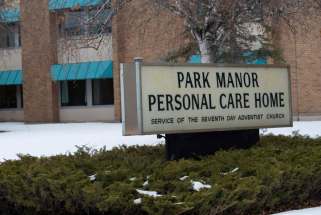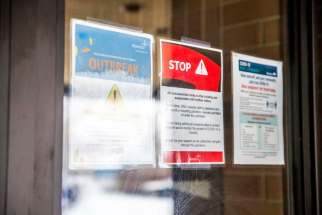Province crawls in race to protect its most vulnerable
Read this article for free:
or
Already have an account? Log in here »
To continue reading, please subscribe:
Monthly Digital Subscription
$0 for the first 4 weeks*
- Enjoy unlimited reading on winnipegfreepress.com
- Read the E-Edition, our digital replica newspaper
- Access News Break, our award-winning app
- Play interactive puzzles
*No charge for 4 weeks then price increases to the regular rate of $19.00 plus GST every four weeks. Offer available to new and qualified returning subscribers only. Cancel any time.
Monthly Digital Subscription
$4.75/week*
- Enjoy unlimited reading on winnipegfreepress.com
- Read the E-Edition, our digital replica newspaper
- Access News Break, our award-winning app
- Play interactive puzzles
*Billed as $19 plus GST every four weeks. Cancel any time.
To continue reading, please subscribe:
Add Free Press access to your Brandon Sun subscription for only an additional
$1 for the first 4 weeks*
*Your next subscription payment will increase by $1.00 and you will be charged $16.99 plus GST for four weeks. After four weeks, your payment will increase to $23.99 plus GST every four weeks.
Read unlimited articles for free today:
or
Already have an account? Log in here »
Hey there, time traveller!
This article was published 10/12/2020 (1825 days ago), so information in it may no longer be current.
With multiple COVID-19 deaths at personal care homes reported daily, it’s clear the province has dropped the ball on protecting Manitoba’s most vulnerable citizens.
The question now: with a vaccine still months away for most Manitobans, what is the Pallister government planning to do about it?
As of Dec. 1, 168 personal care home and assisted living facility residents had died of COVID-19. The problem has worsened over the past 10 days: a further, staggering 71 such deaths, including nine Thursday.
In Winnipeg, 32 of 39 long-term care facilities have outbreaks; 15 have active cases. There are eight large-scale current outbreaks at city nursing homes.
With a test positivity rate above 13 per cent, widespread community transmission, and the likelihood of greater spread over the holidays, those numbers will almost certainly get worse.
It’s a disaster.

Senior Manitoba health officials say they did everything possible to protect nursing homes from the expected second wave of COVID-19. But beyond implementing a one-site policy in the spring to prevent some health-care staff from working at multiple nursing homes, it’s unclear what those steps were.
When an outbreak at Maples care home in early November revealed chronic understaffing and severely neglected residents, Health Minister Cameron Friesen blamed health officials for not bringing concerns to his attention.
The day after the Maples incident went public, Friesen bragged how quickly his government had implemented the one-site policy, months earlier.
“We believe that that one measure alone — extraordinary measure — has saved lives,” he said.
Perhaps, but the one-site rule also created problems that should have been addressed long ago.
Under the policy, personal care homes must ensure staff have not worked at another nursing home in the previous 14 days. It’s designed to reduce the spread of SARS-CoV-2 between facilities.
As a result, (care homes) had to rely increasingly on employment agencies for temporary workers. Many of those, including labourers, are exempt from the one-site rule and are free to work at multiple facilities.
It created a new problem: nursing homes can no longer rely on other facilities to fill shifts when workers fall ill or have to stay home to self-isolate. (In Winnipeg, 144 personal care home staff were COVID-positive, as of Dec. 8).
As a result, they’ve had to rely increasingly on employment agencies for temporary workers. Many of those, including labourers, are exempt from the one-site rule and are free to work at multiple facilities.
Maples officials said last month the facility had between 25 to 32 labourers on site in a 24-hour period to help backfill staffing shortages.
Also, the one-site policy only applies to certain employees, such as nurses and health-care aides. It lists 18 groups that are exempt from the order, including dietitians, lab technicians, nurse practitioners, social workers, administrative and clerical staff, managers, supervisors and care co-ordinators.
There is far more risk of spreading the novel coronavirus between facilities than government cares to admit.
Instead of planning for these human resources challenges, many care homes continued to operate at minimal levels of staffing, well into the fall. When Maples requested staffing assistance from the Winnipeg Regional Health Authority prior to its devastating outbreak, it was denied.

Meanwhile, there appears to be no urgency from the Pallister government to respond to an escalating crisis.
Some steps have been taken, including redeploying home care staff to nursing homes and using the Red Cross to help with infection control. Beyond that, it’s as if the province has thrown in the towel and is willing to accept this level of mortality.
When Premier Brian Pallister was asked last month about tapping the Canadian military for support to help with nursing homes, he said it would be a “mistake,” because it would “cast aspersions” on senior health-care officials.
Since then, there have been 28 new outbreaks at personal care homes in Manitoba.
How many more deaths would it take for Pallister to swallow his pride and reach out to the military for help?
For a premier who claims to have a soft spot in his heart for seniors, he sure isn’t acting on it.
tom.brodbeck@freepress.mb.ca

Tom has been covering Manitoba politics since the early 1990s and joined the Winnipeg Free Press news team in 2019.
Our newsroom depends on a growing audience of readers to power our journalism. If you are not a paid reader, please consider becoming a subscriber.
Our newsroom depends on its audience of readers to power our journalism. Thank you for your support.








